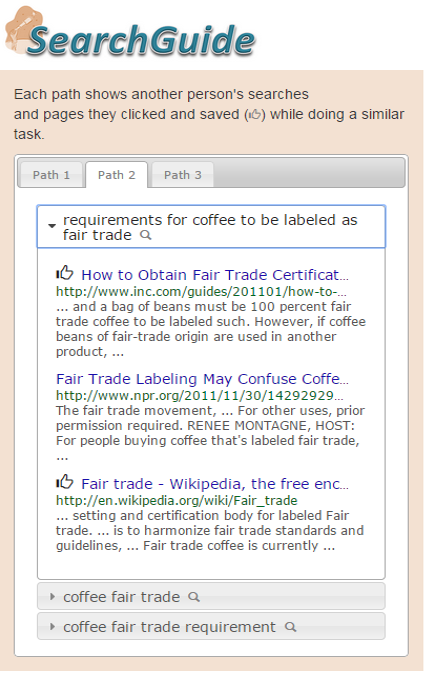
| Home | | Overview |
Overview
Current search systems are effective in helping users complete simple search tasks, but provide less support for complex tasks. When users search for information, they create search trails based on their interactions with the search system. These trails encode valuable information that could benefit a future searcher working on a similar task and may include the queries issued, results clicked, pages viewed, pages bookmarked, and annotations made by a previous searcher. Currently, many search engines use these activity traces to improve result ranking algorithms and features such as query suggestions.However, these approaches are limited; they may lead to indirect benefits, but do not consider the full potential of search trails as a direct form of search assistance. Our ultimate goal is to develop a system that automatically displays search trails as a form of search assistance.
Prior work and our own preliminary study suggest that search trails have strong potential to help users learn about task domains, discover new resources, change search strategies, and verify the accuracy of information. However, there are significant challenges. The system needs to predict when to display search trails to a user, which trails to display, and how to display them in a way that supports the user's goal.
We will address these challenges in three phases. In Phase 1, we will use both qualitative and quantitative methods to investigate how factors of the user, task, and system influence when and how search trails are used. Little prior research has examined these factors, yet understanding their effects is essential to design effective assistance. In Phase 2, we will develop models for predicting when to display search trails to a user. We will use machine learning to combine user and task features, as well as behavioral measures that indicate whether a searcher is having difficulty. In Phase 3, we will develop models for predicting which trails to display in a particular context. We will use learning-to-rank algorithms to combine features that measure the similarity between the current search session and the candidate trail, and the information content in the trail.
This material is based upon work supported by the National Science Foundation under Grant No. 1718295.
Any opitions, findings, and conclusions or recommendations expressed in this material are those of the author(s) and do not necessarily reflect the views of the National Science Foundation.